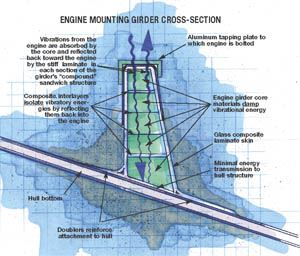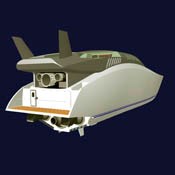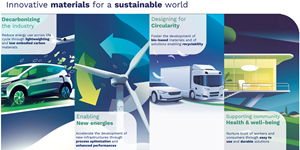Quiet Ride Founded On Composites
Isolation and damping of vibration for acoustic luxury on yachts.
Noise and other types of undesirable vibration pose design problems that require the services of vibro-acoustic engineers. In spacecraft applications, vibration can endanger delicate instruments. Much more often, however, these "vibratory energies" create audible discomfort for passengers in more earthbound modes of transportation, such as motor-yachts.
J&A Enterprises Inc. (Salem, Mass.), which designs noise- and vibration-control solutions for both aircraft interiors and marine vessels, has recently undertaken the acoustic design of a 24m/80-ft, diesel-powered composite yacht, an "express cruiser" with a top speed of 130 kmh/70 knots. Their charge: produce a motor-yacht with a "feel" consistent with passage through water, but without detectable engine noise or vibration produced by high water turbulence — even at top speed. While the yacht is docked, its cabins are to have the acoustic ambience of a luxury hotel.
J&A is performing the work for naval architecture and marine engineering firm Donald L. Blount and Associates Inc. (DLBA, Chesapeake, Va.). The two firms are addressing the 70-knot cruiser's technological challenges with an eye to the future: A concept 46-m/151-ft extreme cruiser, with a top speed of 185 kmh/100 knots, that will run from Norfolk, Va. to Bermuda in only six hours, claims Dean Schleicher, DLBA technical director. Schleicher reports that DLBA has worked through the feasibility design, propulsion studies, structure and seakeeping for the 100-knot cruiser, and is now "waiting for the right client to make this project a reality." With the exception of size, the cruisers are similar in outer design, including the fact that aerodynamics will require passenger spaces to be almost entirely enclosed.
After 37 years of acoustic engineering experience, J&A president Joe Smullin enjoys the challenge of working on the cruisers, a challenge that remains fresh as composites have replaced metal in boat construction.
"Metal boats consist of thin plates with stiffeners, which means you must build an interior surface," Smullin explains. "In metal boats, structure is, by definition, different from surface." Where a metal structure will transmit undesirable vibratory energy, the separate inner skin, which must be manufactured in any case, can be acoustically isolated from the structure to prevent transmission of sound into "receiver spaces" where passengers will be found. In contrast, molded composites often combine structure and interior surface. On passenger vessels, where space is at a premium, composites provide more efficient use of available space, but the structure also becomes a central factor in the noise-control equation — a reality somewhat unique to composites, says Smullin. Therefore, engineers must address noise transmission in the structure's design. The more the composite structure itself can control acoustic and other vibratory energies, the fewer otherwise unnecessary add-ons a yacht will require for noise control.
Transmission of vibratory energies into "receiver spaces" is the chief concern. On the express cruiser project, that task will be made more difficult by the fact that undesirable vibration will be generated not only by internal mechanical systems (engines, air-conditioning systems and the waterjets that will propel this vessel), but from unusually high water excitation of the exterior hull panels at high cruising speeds.
Smullin is quick to point out that the goal is not complete elimination of noise and vibration, but reduction to levels at which passengers are effectively unaware of them. "We will provide good privacy between cabins," he predicts, "and docked cabin noises will not exceed 40 dB, even when air conditioning is on. We'll do this at very low weight and using limited space." To reach the goal, Smullin says J&A will have to push current concepts in composite laminate design.
VIBE MODEL
For that reason, J&A has become involved in the cruiser's initial design phase. One of its first tasks is to produce a unified model of transmission in the express cruiser. To do so, J&A is combining finite element analysis (FEA), using MSC.NASTRAN from MSC.Software Corp. (Santa Ana, Calif.), with its own, internally developed statistical energy analysis (SEA) modeling and a blend of other calculations — a sophisticated approach for a complex problem.
SEA predicts and analyzes the behavior of a structure subject to medium- to high-frequency vibratory sources. The marine vessel (or other structure) is viewed as an assembly of interconnected subsystems, and SEA parameters, such as modal densities, transfer functions, and damping and coupling losses, are factored in to determine this behavior, and ultimately to predict the vibration responses in receiver spaces. Input data for the acoustic response characteristics of the composite structures come from J&A's vast database, created through empirically testing and characterizing noise and vibration transmission in different types of materials and structural geometries. A variety of composite materials fall within the range of useful specific strengths and stiffnesses for the express cruiser, so J&A also is differentiating the vibro-acoustic performance of each. Among reinforcements, for example, aramid typically offers greater damping than carbon or glass. Among cores, metal honeycomb typically offers greater shear stiffness than thermoplastic honeycombs, but thermoplastic honeycomb generally offers more effective vibratory damping. For homogenous core materials, linear foams (polyvinyl chloride [PVC] and styrene acrylonitrile [SAN]) generally offer better damping properties than the stiffer, crosslinked PVC's and balsa cores, Smullin reports. Since core materials, reinforcement plies and ply structure all affect a sandwich construction's overall damping performance, the company is making and testing samples of candidate panel constructions. The results are laid out across a performance grid. This process helps determine the optimum solutions. J&A is providing this critical information to DLBA prior to material selection. After DLBA selects material candidates, J&A will perform more vibro-acoustic testing prior to final material specification.
Smullin anticipates that a carbon/aramid sandwich construction, using Corecell structural foam core from SP (Magog, Quebec, Canada) will be selected for the express cruiser's hull structure. SP's Ampreg-series epoxy is a strong candidate for the matrix resin. He expects a glass/aramid sandwich construction, with the same resin and core as the hull, to comprise the yacht's superstructure. Interior panels will likely employ glass and/or aramid with Nomex honeycomb core from DuPont Advanced Fiber Systems (Richmond, Va.).
SOUND SHAPES
One key area of concern is the chine, the sharp longitudinal corner on each side of the boat where the side and bottom of the hull intersect. Below the chine "crease" on a high-speed boat, the hull curves in and down to direct water downward, which raises the hull in the water to decrease drag. During high-speed travel, significant turbulence and cavitation excitation at the chines (the mid-level- and high-frequency noise created when pressure gradients form vapor bubbles that repeatedly collapse on the hull surface), is hard for passengers to speak over. Low-frequency thumping noises are generated when wave impacts cause hinging around the chine — flexing at the joint between the two panels — both during travel and while the yacht is docked.
Smullin says the typical chine has an internal angle at the joint between the bottom and top panels of about 120°. While structural requirements might be satisfied with vertical frame members about 1.8m/6-ft apart, this construction leaves an unsupported 6-ft panel section, along which noise is easily transmitted. J&A advises cross-stiffening by increasing the core thickness on the inside of this horizontal joint, filling the angle with core material, up to perhaps 15 cm/6 inches at its thickest point. The result is a more sculpted, continuous internal surface at the chine, which helps resist hinging, and thus, generation and transmission of low-frequency noise. Cross-stiffening takes up otherwise unused space, such as voids behind cabinetry and built-in furniture, Smullin notes, except in the bow area where it reduces the floorboard space slightly. The added weight, likely less than 3 percent of overall hull weight, is inconsequential, he adds.
BLOCKING THE ENGINE BLOCK
A primary concern is the express cruiser's engine room, where engineers will suppress vibratory energy using isolation, which reduces the energy transmitted across boundaries, and damping, which reduces the magnitude of that energy as it travels through a structure by converting it into heat energy. Smullin points out that the techniques often operate in complementary fashion. In the present case, the express cruiser will have a noncomposite "double-wall" type of overhead and forward bulkhead insulation to reflect noise back into the engine room. Smullin explains that through-wall acoustic transmission depends on the wall's mass. Doubling a single wall's mass might reduce transmission an additional 25 to 30 percent, but adding a second wall of the same mass, with a small dead-air space between the two walls, reduces transmission an additional 100 percent. The double wall consists of a structural wall and a wall made from acoustic vinyl or metal. The reflected sound is damped by absorptive sheets of fire-resistant, lightweight polyimide, fastened in place with elastic bushings (sheets and bushings from J&A's sister firm, Soundown (Salem, Mass.), or bonded using elastomeric adhesive from Getzner Werkstoffe GmbH (Bürs/Bludenz, Austria).
J&A will reduce engine noise transmission into the hull, with the design of the engine block's foundation: a 3.7m to 4.6m (12 ft to 15 ft) long section of two girders that will run the length of the hull. The engine will straddle the girders, each akin to a box beam, approximately 150 mm/6 inches wide and 460 mm/18 inches deep.
In a conventional girder, glass composite skins would cover a 457-mm/18-inch thick core. But when high-frequency energy traverses such a thick structure, the core can begin to flex within the skin, enabling increased transmission of structure-borne noise. For the express cruiser, therefore, J&A has recommended "soft" engine mounts and a "compound" sandwich construction for the girders. featuring a series of cores, alternating with glass skins that run horizontally between these layers and tab into the glass skins on either side (see drawing). The result is a stiffer structural connection that better resists vibrational transmission. To determine the best materials for the mounts and foundation, vibro-acoustic engineers characterize the structure's "mobility," by which they mean the force required at a given energy frequency to cause the structure to vibrate (the higher the force, the lower the mobility). "A soft attachment on top of a rigid foundation reflects sound back into the machine, with little transferred into the hull," Smullin explains. The soft mount is a poor transmission medium for vibratory energies, and the stiff foundation provides very low mobility. Thus, almost all the relatively small amount of energy that traverses the soft mount will be isolated, and very little will reach the hull.
TRADEWINDS
While the engine room's double-wall construction carries a relatively heavy weight penalty, it is much more tolerable in this position — aft and fairly low in the hull — than it would be elsewhere. Likewise, the space penalty paid to use absorptive materials is acceptable, because the materials do not impinge on passenger space.
|
Elsewhere, J&A will contend with weight/damping tradeoffs in vessel locations that have lower tolerance for added weight or lost space. Although material selection component design will go a long way toward noise control, the desired acoustic luxury cannot be achieved in structural design alone. Smullin explains that with composites, the ideal damping material is almost never the ideal structural material. "If you consider that loudspeaker cones are thin, stiff materials," he illustrates, "then you can imagine that composite materials, selected for their light weight and high stiffness, make excellent soundboards — the opposite of what an acoustic engineer wants." As a result, Smullin plans to recommend separate inner wall panels (which may be made from any of a wide range of materials) within the yacht's cabins, supported on elastic isolators to reduce structure-borne excitation. Behind the inner wall panels, a lightweight (4.5 kg/m3) sound absorbing, highly fire-resistant polyimide foam sheet, from Soundown, will be adhesive bonded to the hull to reduce reverberation. |
Related Content
Resins, additives, adhesives and 3D printing solutions
CAMX 2023: Arkema’s broad portfolio of products for composites fabricators aim to enhance performance, durability and sustainability.
Read MorePittsburgh engineers receive $259K DARPA award for mussel-inspired underwater adhesion
The proposed META GLUE takes inspiration from hydrogels, liquid crystal elastomers and mussels’ natural bioadhesives to develop highly architected synthetic systems.
Read MoreComposite resins price change report
CW’s running summary of resin price change announcements from major material suppliers that serve the composites manufacturing industry.
Read MorePark Aerospace launches aerospace, MRO structural film adhesive
Aeroadhere FAE-350-1 is a curing epoxy formulation designed for composite, metal, honeycomb and hybrid applications.
Read MoreRead Next
VIDEO: High-volume processing for fiberglass components
Cannon Ergos, a company specializing in high-ton presses and equipment for composites fabrication and plastics processing, displayed automotive and industrial components at CAMX 2024.
Read MoreAll-recycled, needle-punched nonwoven CFRP slashes carbon footprint of Formula 2 seat
Dallara and Tenowo collaborate to produce a race-ready Formula 2 seat using recycled carbon fiber, reducing CO2 emissions by 97.5% compared to virgin materials.
Read MoreDeveloping bonded composite repair for ships, offshore units
Bureau Veritas and industry partners issue guidelines and pave the way for certification via StrengthBond Offshore project.
Read More
























